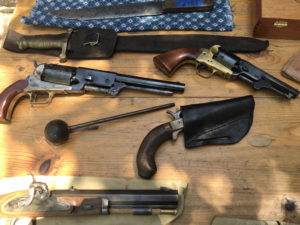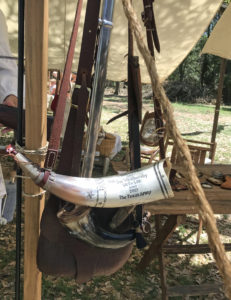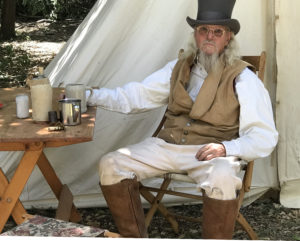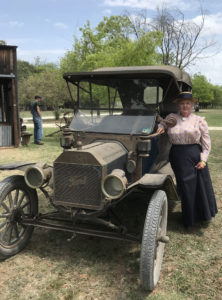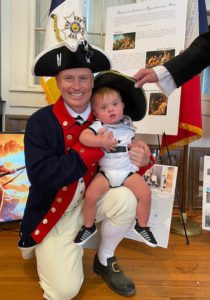Lately I have been refreshing my memory and knowledge of Gold-Rush era California. Relevant volumes are already fringed with small postit notes, making it easier for me to come back to a particularly vivid description of a place, a curious character, the presence of someone later-well-known, or an interesting yet little known turn of events. For example, William Tecumseh Sherman was in California in 1848, as the aide to the American military governor, perhaps – or maybe not – afire with impatient envy of his fellow West Point classmates who were serving in the active theater of the war with Mexico. I had wanted to work him in as a walk-on character in The Golden Road, but my main character’s adventures never intersected with WT Sherman, except for delivering a newspaper to his house in San Francisco.
Anyway, an interesting sidelight to the history of the Gold Rush happened towards the end of that first year, 1849. It seemed as if half the world rushed into California, by land, sea or a combination thereof, eager to start collecting gold nuggets as big as peas and beans (or even bigger) off the ground. Some intrepid gold-seekers came through Mexico, or across Texas and New Mexico Territory, but a substantial number came by the established route; starting from the various jumping-off places along the Mississippi-Missouri. Such adventurers surged along the Platte River to Ft. Laramie, over South Pass, to Fort Hall, the Humboldt River, then up and over the last hurdle of the Sierra Nevada mountain range. At a point in present-day Nevada, the route deviated into several branches.
Those travelers – worn-down by the last few hundred miles through desert, low on supplies, having lost draft animals to hard-use, near-starvation and low-grade harassment by Indians – looked for an easier passage through the high mountains than the difficult Truckee route. They also hoped to avoid the ghastly experience of the Donner-Reed company of three years previous; caught in deep snow, with cannibalism the only alternative to death by starvation. Many chose a slightly easier passage toward the south called the Carson pass. But a portion of the late-season 49ers were diverted north, on a cutoff advertised as a short-cut to the northern gold fields – a short-cut talked up by rancher and entrepreneur Peter Lassen. Which it was, sort of … but it led through the Black Rock Desert and equally hard, waterless country, which demolished morale, supplies, and physical endurance of ‘49ers who were close to the end of all those. (A smaller, very misguided and disjointed company went even further south and blundered into – and out of the Death Valley – rescuing themselves by pluck, luck and the courage of several able members of it.)
The concerted rush of desperate and stressed overland parties arriving at the end of the traveling season gave cause for concern to the then military governor of California. That was General Persifor F. Smith, who seems to have been an able and well-thought-of regular Army officer; an indispensable, experienced but competently colorless man. Around August of 1849, General Smith received the intelligence from arriving overlanders that many parties still on the trail had fallen well behind – and horrifyingly, those parties contained many women and families. Such were still on the far side of the Sierra Nevada and likely to be in deep trouble – and deep snow, since blizzards usually began in late September. Everyone who came overland knew they had to be over the mountains by October, when heavy snow began falling in the high ranges.
General Smith swung into decisive action; he pulled $100,000.00 from his government budget earmarked for civil matters, and $12,000 in donations from residents and businesses in San Francisco, many of whom knew of the perils of the overland trail from previous personal experience. General Smith tasked one of his officers, Major Daniel H. Rucker, to head up the relief effort. Major Rucker was then 37 and had served on the frontier for the previous twelve years. He had married into the wealthy Cherokee Ross family, while serving at Fort Gibson, but his wife had died, leaving him with two surviving children. He was promoted to his rank for conspicuous gallantry in the Battle at Buena Vista, during the recent war with Mexico. Most importantly for this mission he was then serving as a member of the Quartermaster Corps and experienced in managing supplies and transport. He was also a good friend of frontiersman Kit Carson and would eventually be the father-in-law of Philip Sheridan.
Early in September, Major Rucker arrived in Sacramento, the nexus for travel to the gold mines, and the traditional terminus for the overland trail. He had planned on dispatching a pair of well-equipped caravans of pack-mules to follow back along the Truckee and the Carson pass trails, and had purchased wagons, draft animals and supplies and hired men. They would have plenty of food, and plenty of extra animals, resupplying and assisting the lagging, hungry travelers as they went … and their orders were to go as far back long the trail until they were certain there were no more straggling travelers. In talking with recently-arrived ‘49ers, Major Rucker learned to his horror that a substantial number of emigrants had been decoyed onto the new Lassen cutoff, on the assumption that it was a short cut. It wasn’t – and it ran through desert and mountains even more desolate than the 40-Mile desert between the Humboldt Sink and the Truckee River. Immediately, Major Rucker organized a third supply-and-rescue caravan with himself in the lead.
The first relief force worked their way along the Truckee route. By early October, they were able to assure themselves that there was no one else needing help, and they moved to the Carson route – thirty men and a hundred miles, where the need was dire. Not only were those late travelers in danger of repeating the fatal experience of the Donners and the Reeds in the snow – they had already lost their draft animals and run through all their food supplies, trudging through the desert on foot, carrying what little they could salvage. Some had been surviving by salvaging flesh from dead oxen and mules. But the last party on the on the Carson trail were still in good order and assumed that they still had plenty of time. They took some convincing from the rescue caravan to ditch some of their gear and hurry the women and children along. That party, once brought to see reason, made it over the mountain pass and safely into the settlements by the time the first winter storms began late in October.
Major Rucker and his team, meanwhile, were heading north, where another epic of snow and starvation was about to unfold. Not only was the Lassen trail even rougher than the Truckee and Carson routes – but it dumped out a good two hundred miles away from the gold fields. Practically everyone who followed it to the end wished that they hadn’t – and many suspected (with reason) that Peter Lassen had played it up in order to enrich his own enterprises from the passing traffic on the trail. (Lassen was killed by parties unknown, a decade later, under mysterious circumstances.) Rucker’s team, working back along the trail encountered the most heartrending scenes of sickness and deprivation. In his after-action report to General Smith, Rucker wrote: “A more pitiable sight I had never before beheld. There were cripples from scurvy, and other diseases; women, prostrated by weakness, and children, who could not move a limb. In advance of the wagons were men mounted on mules, who had to be lifted on or off their animals, so entirely disabled had they become from the effect of scurvy.” Being a stalwart gentleman of that era – as well as a widower and father – must have lent special urgency to Rucker’s determination to assist as many stricken and desperate travelers as possible. By the end of November, his people had rounded up the last of the stragglers along Lassen’s trail and conveyed them to relative safety. Of course, they weren’t able to save everyone who ran into trouble on the last months of 1849 – but they were seen as rescuing angels by many men and women – who were pretty certain they would have died, otherwise. Among the families rescued by Rucker’s task force were the parents and older sister of philosopher and idealist Josiah Royce.
When Daniel Rucker died in 1910, he had served for 45 years, almost all of his service after 1850 in the Quartermaster Corps, including throughout the Civil War. Eventually he was promoted to the post of Quartermaster General. He married again, the year after the eventful rescue mission in California – it was a daughter of this marriage who later married Phillip Sheridan. Should the DOD ever move to restore the Rucker name to Fort Rucker, they couldn’t do any better than naming it after Daniel Rucker, Army Quartermaster General.

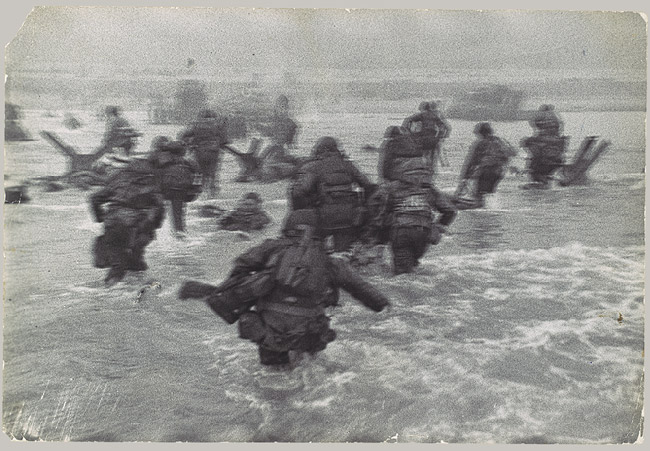 So this is one of those historic dates that seems to be slipping faster and faster out of sight, receding into a past at such a rate that we who were born afterwards, or long afterwards, can just barely see. But it was such an enormous, monumental enterprise – so longed looked for, so carefully planned and involved so many soldiers, sailors and airmen – of course the memory would linger long afterwards.
So this is one of those historic dates that seems to be slipping faster and faster out of sight, receding into a past at such a rate that we who were born afterwards, or long afterwards, can just barely see. But it was such an enormous, monumental enterprise – so longed looked for, so carefully planned and involved so many soldiers, sailors and airmen – of course the memory would linger long afterwards.

